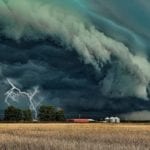 Creepy
Creepy  Creepy
Creepy  Technology
Technology 10 Scientific Breakthroughs of 2025 That’ll Change Everything
 Our World
Our World 10 Ways Icelandic Culture Makes Other Countries Look Boring
 Misconceptions
Misconceptions 10 Common Misconceptions About the Victorian Era
 Mysteries
Mysteries 10 Strange Unexplained Mysteries of 2025
 Miscellaneous
Miscellaneous 10 of History’s Most Bell-Ringing Finishing Moves
 History
History 10 Great Escapes That Ended Right Back in Captivity
 Weird Stuff
Weird Stuff 10 Fascinating Things You Might Not Know About Spiders
 Food
Food 10 Everyday Foods You Didn’t Know Were Invented by the U.S. Military
 History
History 10 Odd Things Colonial Americans Kept at Home
 Creepy
Creepy 10 More Representations of Death from Myth, Legend, and Folktale
 Technology
Technology 10 Scientific Breakthroughs of 2025 That’ll Change Everything
 Our World
Our World 10 Ways Icelandic Culture Makes Other Countries Look Boring
Who's Behind Listverse?

Jamie Frater
Head Editor
Jamie founded Listverse due to an insatiable desire to share fascinating, obscure, and bizarre facts. He has been a guest speaker on numerous national radio and television stations and is a five time published author.
More About Us Misconceptions
Misconceptions 10 Common Misconceptions About the Victorian Era
 Mysteries
Mysteries 10 Strange Unexplained Mysteries of 2025
 Miscellaneous
Miscellaneous 10 of History’s Most Bell-Ringing Finishing Moves
 History
History 10 Great Escapes That Ended Right Back in Captivity
 Weird Stuff
Weird Stuff 10 Fascinating Things You Might Not Know About Spiders
 Food
Food 10 Everyday Foods You Didn’t Know Were Invented by the U.S. Military
 History
History 10 Odd Things Colonial Americans Kept at Home
10 Devastating Airburst Events from History
Space is a messy place, full of large rocks (and possibly other things) that, at any moment, could come hurtling toward us at high speed. Most of these objects are small enough that they become bright streaks of light in the night sky as they burn and break apart.
Sometimes, these objects will violently explode in an “airburst.” And on very rare occasions, an airburst will happen close to the ground with devastating results. Here are 10 devastating airburst events from history.
Related: Top 10 Facts About Asteroid Mining
10 1908: Tunguska Event
The Tunguska Event of 1908 is the largest known airburst in history. In the early morning hours of June 30, 1908, an object entered the Earth’s atmosphere, making a beeline for a remote region in Siberia near the Tunguska River. The object exploded several miles above the Earth’s surface with force a thousand times more powerful than the atomic bomb dropped on Hiroshima. It flattened some 500,000 acres (2,000 sq km) of trees, and the force of the explosion was detected as far away as Western Europe.
To this day, we are still unsure what exactly the object was, how big it was, or what it was made of since there was no impact crater and very little was recovered at the site. Conspiracy theories range from a black hole hitting the Earth to an alien UFO exploding. Russia has helped keep the UFO theory alive, with wild claims of alien metal or other technical devices discovered in the region.[1]
9 1490: Ch’ing-yang Event
Unlike Tunguska, the 1490 event in Ch’ing-yang, China, is reported to have had thousands of deaths and injuries. Records claim that up to 10,000 people were killed in March or April of that year when “stones fell like rain” on the city. Scientists today believe a meteor shower alone is unlikely to have caused so many deaths. However, an airburst the size of Tunguska could be a possible explanation.
It is worth noting that in January of the same year, astronomers in Japan, China, and Korea discovered comet C/1490 Y1, whose destruction led to the annual Quadrantid meteor shower, which we can still see today. Are the two events related? Scientists are unsure, but it is quite a coincidence otherwise.[2]
8 1650 BC: Tall el-Hammam Event
Many are familiar with the biblical story of Sodom and Gomorrah being destroyed in a rain of fire and brimstone from the heavens. Well, scientists think they may have found the ancient city which inspired the stories. It was not a vengeful god who destroyed the city but rather an object from space that was in the wrong place at the wrong time.
Tall el-Hammam was a bustling Bronze-Age city just north of the Dead Sea. Around 1650 BC, the city and the area around it were suddenly abandoned for 300-600 years. Excavations of the site have found evidence that the palace complex in the city was violently destroyed around this time. The ancient city is blanketed by a thick layer of carbon and ash, with melted pottery, plaster, and various metals.
For this to happen, it would have required temperatures in the range of 3600°F (2000°C), far hotter than any fire or even lava, spread across the entire city. Only a cosmic airburst could plausibly explain this mysterious destruction event.
Like Tunguska, there is no evidence of a crater or debris of the object, so we can not say for certain what it was. All we know is that Tell el-Hammam experienced something which caused widespread destruction and extremely high temperatures.[3]
7 10,700 BC: Abu Hureyra Event
Abu Heureya was a Paleolithic village in modern-day Syria. It is also the earliest evidence we have of an airburst event directly affecting humans.
The story of Abu Hureyra is much like Tall el-Hammam. There is evidence of an ancient settlement with an even older settlement under it. In between is a layer of ash and materials that melted at very high temperatures. Scientists believe that a comet entered the atmosphere and broke apart. Several of the pieces then exploded in airbursts. One of these exploded right over Abu Hureyra.
Sadly, with the construction of the Tabqa Dam in 1974, the Abu Hureyra site was flooded. It now sits at the bottom of Lake Assad, so we are not likely to learn more about this event any time soon.[4]
6 252-383: Hopewell Event
The Hopewell were a Native American people who lived in what is now southern Ohio. They are well-known for their mound building. They were also great traders who had connections as far north as the Canadian Great Lakes and as far south as the Gulf of Mexico. In short, things were going good for the Hopewell… until suddenly they weren’t. We do not know exactly when it happened, but there is strong evidence that the Hopewell experienced a comet airburst.
Around the year 400, the archeological history of the once-thriving Hopewell culture begins to suddenly dry up. Other tribes in the area have stories of “a horned serpent that flew across the sky and dropped rocks onto the land before plummeting into the river,” a “sky panther that had the power to tear down a forest.” and “a day when the sun fell from the sky.” Scientists have found comet pieces and “chemical fingerprints” at Hopewell sites from around this time. Also, some Hopewell jewelry from this time was made from comet pieces.
Finally, remember how the Hopewell were known for building mounds? Around this time, the Hopewell people built a mound today known as the Milford Earthworks. What is unique about it is that it is shaped exactly like a comet.[5]
5 1626: Wanggongchang Event
Wanggongchang was the name of an armory in Beijing. And since this was China in the 1600s, this meant the armory was full of gunpowder. On its own merits, it is not noteworthy that an armory full of gunpowder exploded. However, it is notable that there were mysterious events right before the explosion.
It was a clear, calm morning in Beijing on May 30, 1626. Suddenly, there came a loud roaring sound from the sky. It began over the northeast part of the city and then passed to the southwest, where the armory was located. There was a blinding flash of light, then a huge explosion as the armory and everything around it was destroyed in a mushroom cloud. Statues, trees, and bodies were thrown miles away by the blast.
The blast, which killed 20,000, was originally blamed on the careless handling of gunpowder. However, that does not explain the strange details before the explosion. The roaring from the sky, which flew over the city, and the bright light strongly suggest an airburst event. Despite this evidence, no one is 100% sure what happened that day in Beijing.[6]
4 1930: Curuçá River Event
On August 18, 1930, Father Fedele d’Alviano visited an isolated community near the Curuçá River in Brazil. He was met by terrified residents who thought that the world was ending. This seemed like kind of a big deal, so he asked for more details.
He learned that on a quiet, sunny morning five days before his visit, the people of the community witnessed fine red dust falling all around them. This was followed by a rain of white ash. Then there came a loud, piercing whistle followed by three massive explosions, which set fire to the nearby forest and caused a small earthquake. There were also reports of large balls of fire seen in the sky.
In 1931, two newspapers in Italy wrote stories based on Father d’Alvino’s reports. Then everyone just kind of forgot about it for 60 years. Interest was only revived in the mid-1990s when these reports were rediscovered. Expeditions were sent to the region to further investigate.
As with other airburst events, no definitive impact craters were found. Scientists have noted that the event happened around the peak of the annual Perseid meteor shower, which could have been the source of the airburst. However, scientists are still baffled by the reports of the red dust and white ash that fell on the region just before the explosions.[7]
3 1888: Sulaymaniyah Event
It is not certain that what happened in Sulaymaniyah, Iraq, was an airburst event. Like the previous entry, this event was mostly unknown until fairly recently.
In 2020, Turkish researchers were reading through old archives of the Turkish government. Many of the records were about mundane events. Then they found letters written about a very non-mundane event: The earliest evidence of a person being hit and killed by a meteorite.
According to the report, people in Sulaymaniyah witnessed fireballs falling from the sky over a ten-minute period on August 12, 1888. One of these fireballs made it close to or all the way to the ground. It slammed into a nearby hillside. One man was killed, and another was severely injured. It is unclear if the object was an intact meteorite or the pieces of an airburst. Since this information has only recently been rediscovered, researchers are working on learning more about this event.[8]
2 2013: Chelyabinsk Meteor
The Chelyabinsk meteor is probably familiar to most people reading this, as it only happened 10 years ago. It was widely filmed and discussed in the media and among scientists. On the morning of February 15, 2013, a small asteroid entered the Earth’s atmosphere from the direction of the sun. Because of this, it went undetected and caught the world by surprise. It finally exploded in a spectacular airburst over the Chelyabinsk region of Russia.
Thankfully, the Chelyabinsk meteor exploded quite high in the sky, so the full force of the explosion was not felt on the ground. Still, the explosion caused millions of dollars of damage and injured thousands. Had the airburst happened closer to the ground, we would be talking about thousands of “deaths” instead of “injuries.”
This event was seen as a wake-up call. Scientists around the world called for more serious observation to detect future asteroids and meteors.[9]
1 1972: Great Daylight Fireball
The 1972 Great Daylight Fireball is unique on this list because, as far as we know, it never exploded. On August 10, 1972, many people observed a fiery object moving across the sky over the western United States and Canada. The object entered the atmosphere at a shallow angle and then left the atmosphere again without exploding or hitting the Earth. Based on its flight path, scientists predicted that the object would return to Earth’s atmosphere in 1997.
But then a funny thing happened: 1997 came and went, and the object did not return as predicted. What happened to it? Did it somehow get knocked out of its orbit? Did it break apart? Did it return, and we just missed it? Or is it still lurking out there, destined to become the next devastating airburst event?[10]








